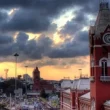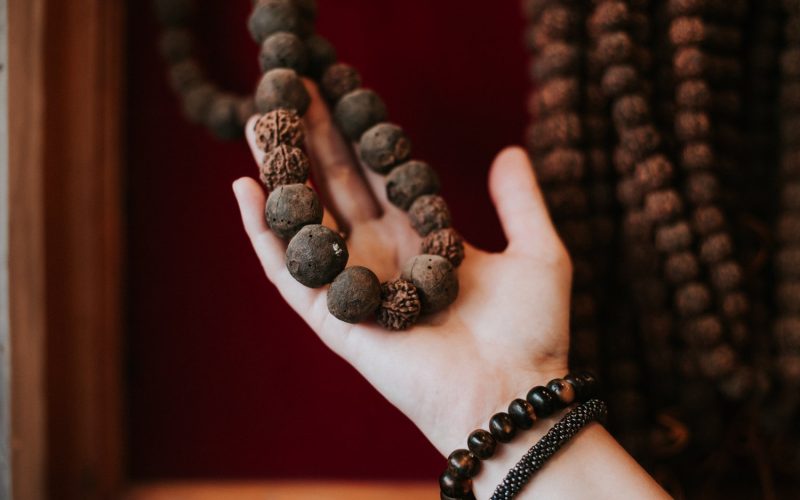Introduction
The decision to embrace a Rudraksha Mala is often a deeply personal one, marking a significant step on a spiritual journey or a quest for enhanced well-being. But once you’ve decided to welcome this sacred energy into your life, a new question arises: how do you choose the perfect Rudraksha Mala for you? With a diverse array of Mukhis (faces), origins, and qualities, the selection process can seem daunting for a beginner.
This guide aims to demystify the process, helping you navigate the options and choose a sacred strand that truly resonates with your intentions and needs.
More Than Just an Accessory: Understanding Your Intention
Before you even start looking at beads, the most crucial step is to understand your intention. Why do you want to wear a Rudraksha Mala? Are you seeking:
- Inner Peace and Stress Reduction?
- Improved Focus and Concentration?
- Enhanced Spiritual Growth and Meditation?
- Protection from Negative Energies?
- Better Health and Vitality?
- Specific astrological remedies or addressing planetary influences?
- Attracting abundance or success?
Your intention will be the guiding light in selecting the appropriate Rudraksha Mukhi (number of faces) and even the specific origin.
The Heart of the Matter: Understanding Rudraksha Mukhis
The most defining characteristic of a Rudraksha bead is its Mukhi, or the number of natural lines/facets running from top to bottom. Each Mukhi is associated with specific deities, planets, and, most importantly, distinct benefits.
Here’s a breakdown of the most common and significant Mukhis, and what they typically offer:
- One Mukhi Rudraksha (Eka Mukhi): The rarest and most powerful, representing Lord Shiva himself. It is believed to grant spiritual liberation (moksha), extreme good fortune, inner peace, and the ability to overcome worldly attachments. Very high demand means a real Rudraksha Mala price for a genuine 1 Mukhi can be substantial, often making it a collector’s item.
- Two Mukhi Rudraksha (Dwimukhi): Symbolizes Ardhanarishvara (Shiva and Parvati united). It fosters unity, harmony in relationships (marital, family, professional), and inner balance. Beneficial for managing emotions.
- Three Mukhi Rudraksha (Trimukhi): Associated with Agni (the fire god) and also Brahma, Vishnu, and Mahesh. It is said to burn away past karma, release guilt, enhance self-confidence, and aid in controlling anger.
- Four Mukhi Rudraksha (Chaturmukhi): Represents Lord Brahma. It enhances intellect, creativity, communication skills, and learning abilities. Excellent for students, teachers, researchers, and artists.
- Five Mukhi Rudraksha (Panchamukhi): The most common and widely available, representing Lord Shiva (Kala Agni Rudra). It is a universal bead for general well-being, peace, good health, and overall purification. It’s excellent for beginners and helps in balancing all chakras. Many opt to buy Rudraksha Mala of 5 Mukhi as a starting point.
- Six Mukhi Rudraksha (Shatmukhi): Symbolizes Lord Kartikeya (Skanda), the son of Shiva. It enhances willpower, courage, leadership qualities, self-expression, and removes obstacles. Beneficial for public speakers and leaders.
- Seven Mukhi Rudraksha (Saptamukhi): Associated with Goddess Lakshmi, the goddess of wealth and prosperity. It is believed to attract abundance, financial stability, and bring good fortune. It also helps in overcoming financial problems.
- Eight Mukhi Rudraksha (Ashtamukhi): Represents Lord Ganesha, the remover of obstacles. It brings success, stability, and helps in overcoming challenges and adversities.
- Nine Mukhi Rudraksha (Navmukhi): Associated with Goddess Durga and the nine forms of Shakti. It provides protection from evil forces, instills fearlessness, and boosts energy and dynamism.
- Ten Mukhi Rudraksha (Dashamukhi): Represents Lord Vishnu. It acts as a powerful protective shield against negative influences, black magic, and evil eyes. It brings peace and harmony.
- Eleven Mukhi Rudraksha (Ekadashamukhi): Symbolizes Lord Hanuman and is believed to grant courage, wisdom, self-control, and success in all ventures. Ideal for meditators and those seeking spiritual discipline.
- Twelve Mukhi Rudraksha (Dwadasamukhi): Represents Lord Surya (the Sun God). It bestows leadership qualities, brilliance, fame, power, and removes issues related to the eyes and bones.
- Thirteen Mukhi Rudraksha (Trayodashamukhi): Associated with Lord Indra and Lord Kamadeva. It brings charisma, charm, success in love, and fulfills desires.
- Fourteen Mukhi Rudraksha (Chaturdashamukhi): Known as the Devamani, or divine gem, representing Lord Hanuman and Lord Shiva. It awakens intuition, enhances decision-making, and protects against misfortune.
The Importance of Origin: Nepali vs. Indonesian
Rudraksha beads primarily come from two regions: Nepal and Indonesia. While both are genuine Rudrakshas, they have distinct characteristics and are often chosen for different reasons:
- Nepali Rudraksha: Generally larger, heavier, and more developed with clearer, deeper Mukhi lines. They are highly sought after for their potent energy and considered superior by many spiritual practitioners. Due to their rarity and perceived potency, Nepali Rudrakshas usually command a higher real Rudraksha Mala price.
- Indonesian (Java) Rudraksha: Smaller, lighter, and smoother with less defined Mukhi lines. They are more abundant and thus more affordable. While generally considered less potent than their Nepali counterparts, they are still effective and popular, especially for those who prefer smaller beads or have budget constraints.
Both origins carry the same fundamental energy, but Nepali beads are often preferred for strong spiritual practices, while Indonesian beads are excellent for continuous daily wear and general benefits.
Quality and Authenticity: Ensuring Your Sacred Strand is Real
This is paramount. The market is unfortunately flooded with fake or manipulated Rudraksha beads. To ensure you buy Rudraksha Mala that is authentic and effective:
- Natural Mukhis: Inspect the beads closely. Genuine Rudraksha beads have naturally formed lines (Mukhis) that run from top to bottom. These lines should be clear, deep, and unbroken. Fakes often have artificial carvings or are glued.
- Texture and Feel: Authentic Rudraksha beads have a unique, rough, and textured feel, similar to wood. They should not be perfectly smooth or glossy.
- Weight: Genuine beads, especially Nepali ones, have a decent weight. Plastic or wooden fakes will feel unnaturally light.
- Central Hole: A real Rudraksha will naturally have a hole through its center.
- Water Test (Caution Advised): While some people float Rudraksha in water, this is not a definitive test and can damage the bead if not dried properly. Some genuine beads may sink, some may float depending on density and dryness. It’s not recommended as a primary test.
- X-Ray Test: The most reliable method. An X-ray will reveal the internal compartments, which should correspond to the number of external Mukhis, each containing a tiny seed. This is primarily done by labs.
- Reputable Dealers: Always purchase from trusted and certified vendors who can provide laboratory reports or strong guarantees of authenticity. Ask questions, read reviews, and seek recommendations.
Considering Your Personal Needs and Preferences
- Size of Beads: Rudraksha beads come in various sizes. Smaller beads (e.g., 4mm-6mm) are discreet and light, ideal for continuous wear. Larger beads (e.g., 10mm-25mm) are more prominent and often preferred for Japa meditation, as they are easier to hold and move.
- Type of Mala: A 108+1 bead mala is traditional for Japa meditation. You can also find smaller malas (27+1 or 54+1) for shorter meditation sessions or wrist malas/bracelets for daily wear.
- Astrological Considerations: Many people choose Rudraksha beads based on their birth chart and planetary positions. Consulting an experienced astrologer or Rudraksha expert can help you select a Mukhi that harmonizes with your planetary influences and addresses specific challenges. For instance, a 7 Mukhi can help mitigate Saturn’s influence, while a 12 Mukhi can strengthen the Sun.
- Combination Malas: Sometimes, a combination of different Mukhi beads in one mala is recommended to provide a synergistic blend of benefits, addressing multiple aspects of life.
The Real Rudraksha Mala Price: A Range to Expect
The real Rudraksha Mala price varies significantly. It depends on several factors:
- Mukhi: 1 Mukhi beads are the most expensive, followed by higher Mukhis like 14, 13, 12, etc. 5 Mukhi is the most affordable.
- Origin: Nepali Rudrakshas are considerably more expensive than Indonesian (Java) ones.
- Size: Larger beads are generally more expensive than smaller ones of the same Mukhi.
- Rarity: Exceptionally rare beads or those with unique characteristics will fetch higher prices.
- Certification and Dealer Reputation: Certified, authentic beads from reputable sources will naturally cost more due to the assurance of quality.
As a rough guide, a good quality Nepali 5 Mukhi mala might range from ₹1,000 to ₹5,000. Rare 1 Mukhi beads can cost upwards of ₹50,000 to several lakhs, depending on size and authenticity. Indonesian malas are significantly more affordable, with a 5 Mukhi Indonesian mala costing a few hundred rupees. Always be wary of prices that seem “too good to be true” for rare Mukhis.
Conclusion
Ultimately, choosing your sacred strand is about listening to your intuition. While information and expert guidance are valuable, the Rudraksha Mala you choose should feel right to you. It’s a personal journey, and your chosen beads will become a constant companion, a source of energy, and a reminder of your aspirations. By understanding your intentions, exploring the Mukhis, ensuring authenticity, and considering your personal preferences, you can confidently buy Rudraksha Mala that serves as a powerful catalyst for your personal and spiritual growth.












